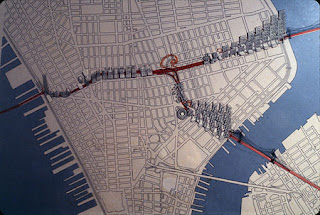With the impending opening of
the “new” Grand
Central Madison rail station serving the LIRR, an important milestone in
the region’s transportation history will be made. And, in historical perspective, one man’s
name comes to mind: Robert Moses.
Awhile back when I gave a guest lecture to a group of urban planning graduate students at UCONN I made reference in the class to Robert Moses and these planners of our future just gave me a blank stare. “You do know who Robert Moses was, don’t you?” I asked. They did not. I was shocked.
 |
| Robert Moses |
What kind of education were they receiving that they didn’t know the name of the single individual who so changed the NYC area’s transportation landscape in the last century.
From the 1930’s to the 1960’s Moses directed the building of 416 miles of parkways (Long Island’s Northern & Southern State and Westchester’s Taconic, to name a few), many bridges (the Tri-Borough, Throgs Neck, Henry Hudson, Verrazano-Narrows as well as the Brooklyn Battery Tunnel) and designed Jones Beach and the NY State Parks system. He orchestrated two Worlds Fairs (1939 and 1964) and helped bring the UN’s headquarters to NYC.
Robert Moses’ grip on power
came from appointment to 12 different job titles though he was never elected to
public office. Despite all this work
he did nothing for mass transit. He loved cars but didn’t really
care for people who did not own them.
In locations where others had envisioned expanding the city’s subway lines, he built roads, displacing thousands of residents. Robert Caro, author of the Pulitzer prize winning biography of Moses, “The Power Broker” even called Moses a racist, because he built motorways for the middle class while discouraging the car-less (people of color) from visiting Jones Beach by making the parkway bridges too low for buses.
 |
| Robert Caro |
He opposed blacks moving into Stuyvesant Town, a Manhattan development on the lower east side for veterans. City swimming pools in black neighborhoods were kept cold to discourage blacks from using them.
Moses’ dénouement came when he
tried to build the elevated, ten-lane Lower Manhattan
Expressway which would have connected the Holland Tunnel to the Manhattan
Bridge straight through Greenwich Village and Little Italy, evicting 2000
families and 800+ businesses. “The Master Builder” called it “slum
clearance”, but residents like Jane Jacobs (author
of the “Death and Life of Great American Cities”) fought back and the city’s
artistic heart was saved.
 |
| Proposed Lower Manhattan Expressway |
Robert Moses was not an evil
man but a product of his time. Today, many hail his accomplishments
and think we need a benevolent despot like him to get things done in
transportation and urban planning, even if a few people get hurt along the
way. It’s all for the greater good, Moses once said:
"I raise my stein
to the builder who can remove ghettos without moving people as I hail
the chef who can make omelets without breaking eggs."
History will judge Moses…
those he helped and those he hurt. Love the omelet, forget
about the eggs? But for graduate
students at UCONN to be unaware of this man, what he built and how, worries me
greatly. To paraphrase George Santayana: those who cannot
learn from history are doomed to repeat it.



No comments:
Post a Comment